lock YAMAHA XMAX 400 2015 Owners Manual
[x] Cancel search | Manufacturer: YAMAHA, Model Year: 2015, Model line: XMAX 400, Model: YAMAHA XMAX 400 2015Pages: 92, PDF Size: 7.29 MB
Page 6 of 92

TABLE OF CONTENTSSAFETY INFORMATION.................. 1-1
Further safe-riding points ............... 1-5
DESCRIPTION.................................. 2-1
Left view ......................................... 2-1
Right view ....................................... 2-2
Controls and instruments ............... 2-3
INSTRUMENT AND CONTROL
FUNCTIONS...................................... 3-1
Immobilizer system......................... 3-1
Main switch/steering lock............... 3-2
Indicator lights and warning
lights............................................ 3-3
Speedometer .................................. 3-5
Tachometer .................................... 3-6
Multi-function display ..................... 3-6
Anti-theft alarm (optional) ............. 3-10
Handlebar switches ...................... 3-10
Front brake lever .......................... 3-11
Rear brake lever ........................... 3-12
ABS (for ABS models) .................. 3-12
Fuel tank cap ................................ 3-13
Fuel ............................................... 3-14
Catalytic converters...................... 3-15
Seat .............................................. 3-16
Storage compartments................. 3-16
Adjusting the shock absorber
assemblies ................................ 3-18
Sidestand ..................................... 3-18
Ignition circuit cut-off system ....... 3-19FOR YOUR SAFETY –
PRE-OPERATION CHECKS............. 4-1
OPERATION AND IMPORTANT
RIDING POINTS................................ 5-1
Starting the engine .......................... 5-1
Starting off ...................................... 5-2
Acceleration and deceleration ........ 5-3
Braking ............................................ 5-3
Tips for reducing fuel
consumption ................................ 5-4
Engine break-in ............................... 5-4
Parking ............................................ 5-5
PERIODIC MAINTENANCE AND
ADJUSTMENT................................... 6-1
Owner’s tool kit ............................... 6-2
Periodic maintenance chart for the
emission control system .............. 6-3
General maintenance and
lubrication chart ........................... 6-4
Removing and installing panels ...... 6-8
Checking the spark plug ............... 6-11
Engine oil and oil filter element ..... 6-13
Final transmission oil..................... 6-15
Coolant.......................................... 6-16
Air filter elements and check
hoses and V-belt case air filter
element ...................................... 6-18
Checking the throttle grip free
play ............................................ 6-20Valve clearance............................. 6-20
Tires .............................................. 6-21
Cast wheels .................................. 6-22
Checking the front and rear brake
lever free play ............................ 6-23
Checking the front and rear brake
pads .......................................... 6-24
Checking the brake fluid level ...... 6-24
Changing the brake fluid .............. 6-26
Checking and lubricating the
cables ........................................ 6-26
Checking and lubricating the
throttle grip and cable ............... 6-26
Lubricating the front and rear
brake levers ............................... 6-27
Checking and lubricating the
centerstand and sidestand........ 6-27
Checking the front fork ................. 6-28
Checking the steering................... 6-29
Checking the wheel bearings ....... 6-29
Battery .......................................... 6-29
Replacing the fuses ...................... 6-31
Replacing a headlight bulb ........... 6-32
Tail/brake light .............................. 6-33
Front turn signal light .................... 6-33
Replacing a rear turn signal light
bulb ........................................... 6-33
Replacing the license plate light
bulb ........................................... 6-34
Auxiliary light ................................ 6-35
Troubleshooting............................ 6-35U1SDE1E0.book Page 1 Monday, September 23, 2013 3:55 PM
Page 16 of 92
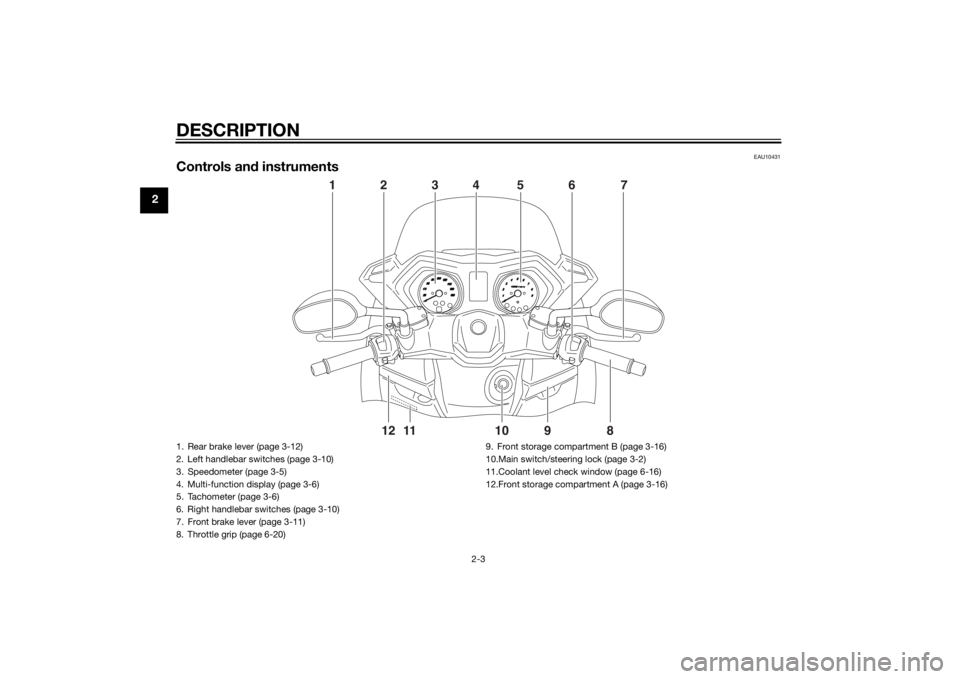
DESCRIPTION
2-3
2
EAU10431
Controls and instruments
4
1
7
5
3
6
2
8
9
10
11 12
1. Rear brake lever (page 3-12)
2. Left handlebar switches (page 3-10)
3. Speedometer (page 3-5)
4. Multi-function display (page 3-6)
5. Tachometer (page 3-6)
6. Right handlebar switches (page 3-10)
7. Front brake lever (page 3-11)
8. Throttle grip (page 6-20)9. Front storage compartment B (page 3-16)
10.Main switch/steering lock (page 3-2)
11.Coolant level check window (page 6-16)
12.Front storage compartment A (page 3-16)U1SDE1E0.book Page 3 Monday, September 23, 2013 3:55 PM
Page 18 of 92
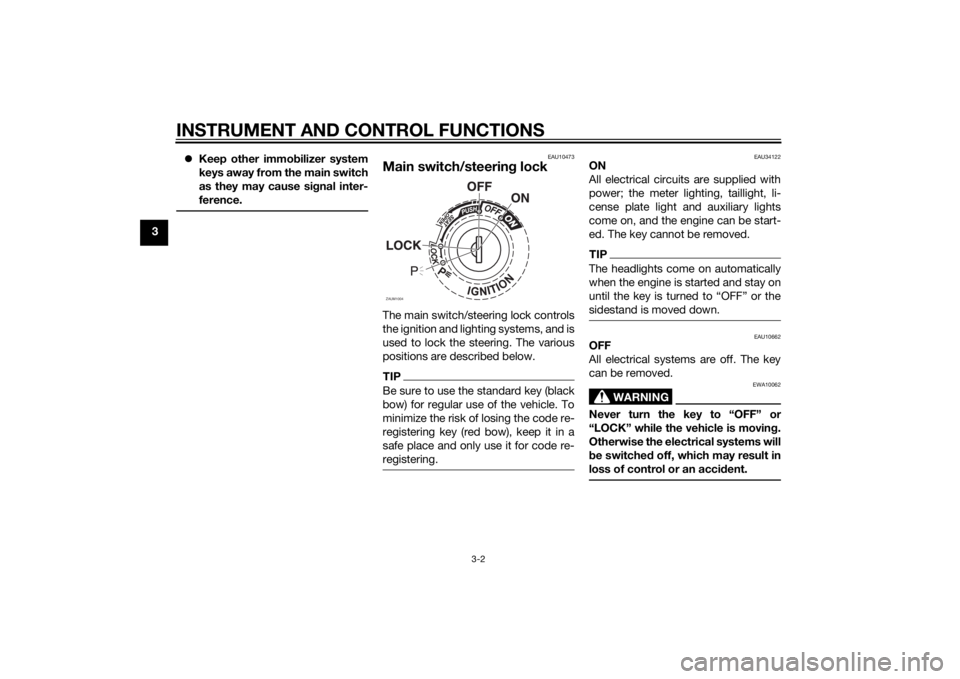
INSTRUMENT AND CONTROL FUNCTIONS
3-2
3Keep other immobilizer system
keys away from the main switch
as they may cause signal inter-
ference.
EAU10473
Main switch/steering lockThe main switch/steering lock controls
the ignition and lighting systems, and is
used to lock the steering. The various
positions are described below.TIPBe sure to use the standard key (black
bow) for regular use of the vehicle. To
minimize the risk of losing the code re-
registering key (red bow), keep it in a
safe place and only use it for code re-
registering.
EAU34122
ON
All electrical circuits are supplied with
power; the meter lighting, taillight, li-
cense plate light and auxiliary lights
come on, and the engine can be start-
ed. The key cannot be removed.TIPThe headlights come on automatically
when the engine is started and stay on
sidestand is moved down.
EAU10662
OFF
All electrical systems are off. The key
can be removed.
WARNING
EWA10062
Never turn the key to “OFF” or
“LOCK” while the vehicle is moving.
Otherwise the electrical systems will
be switched off, which may result in
loss of control or an accident.
ZAUM1004
U1SDE1E0.book Page 2 Monday, September 23, 2013 3:55 PM
Page 19 of 92
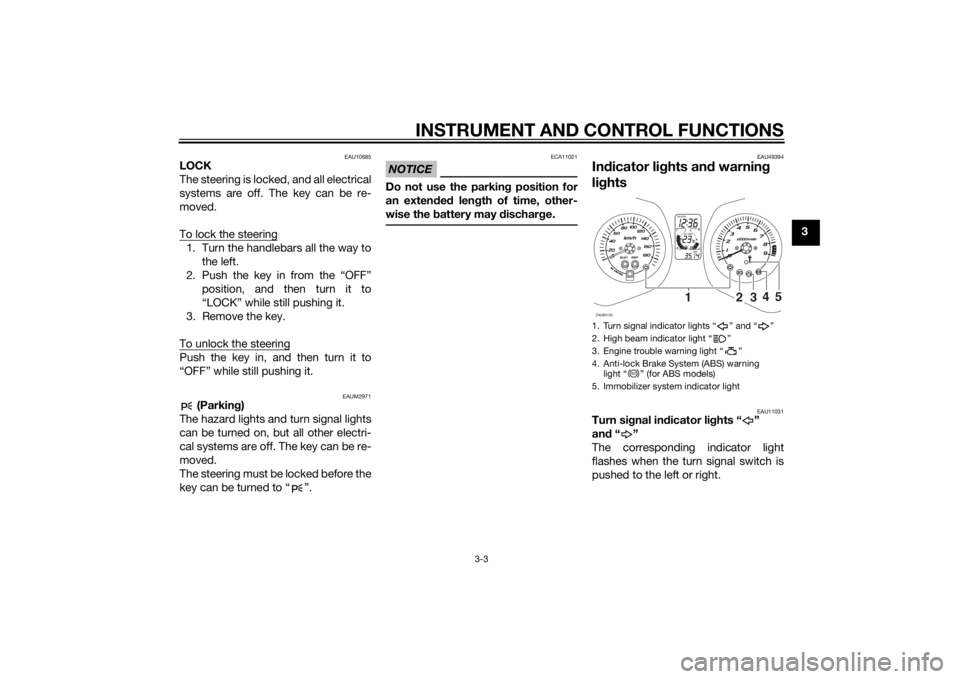
INSTRUMENT AND CONTROL FUNCTIONS
3-3
3
EAU10685
LOCK
The steering is locked, and all electrical
systems are off. The key can be re-
moved.
To lock the steering1. Turn the handlebars all the way to
the left.
2. Push the key in from the “OFF”
position, and then turn it to
“LOCK” while still pushing it.
3. Remove the key.
To unlock the steeringPush the key in, and then turn it to
“OFF” while still pushing it.
EAUM2971
(Parking)
The hazard lights and turn signal lights
can be turned on, but all other electri-
cal systems are off. The key can be re-
moved.
The steering must be locked before the
key can be turned to “ ”.
NOTICE
ECA11021
Do not use the parking position for
an extended length of time, other-
wise the battery may discharge.
EAU49394
Indicator lights and warning
lights
EAU11031
Turn signal indicator lights “ ”
and“”
The corresponding indicator light
flashes when the turn signal switch is
pushed to the left or right.1. Turn signal indicator lights “ ” and “ ”
2. High beam indicator light “ ”
3. Engine trouble warning light “ ”
4. Anti-lock Brake System (ABS) warning
light “ ” (for ABS models)
5. Immobilizer system indicator lightZAUM1132
OIL CHANGE
1/21/2CLOCKOUT TEMP°CODO12
3
4
5
ABS
U1SDE1E0.book Page 3 Monday, September 23, 2013 3:55 PM
Page 20 of 92
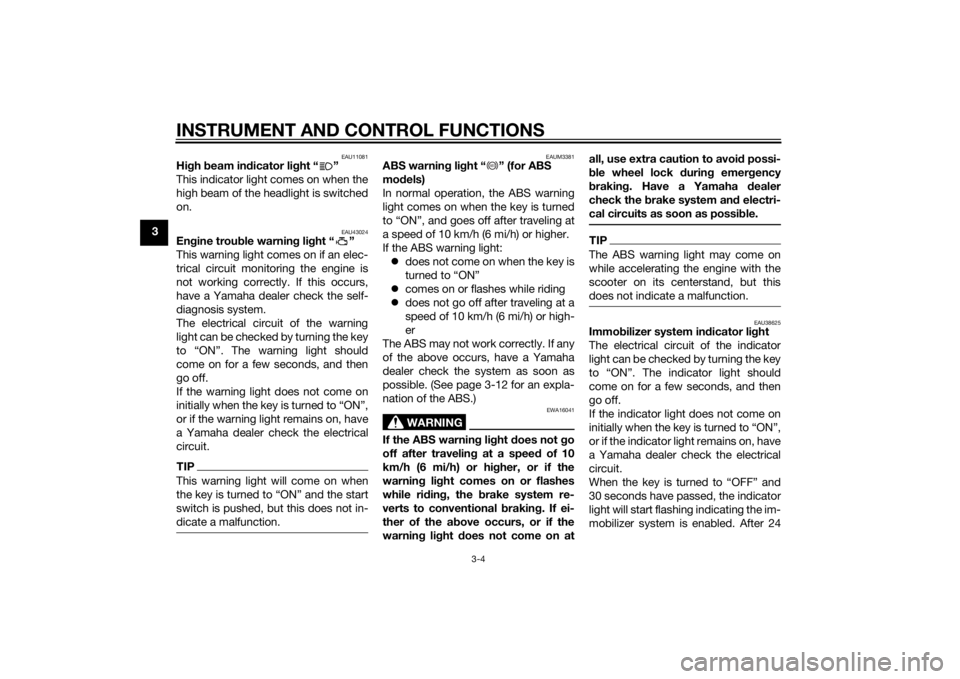
INSTRUMENT AND CONTROL FUNCTIONS
3-4
3
EAU11081
High beam indicator light “ ”
This indicator light comes on when the
high beam of the headlight is switched
on.
EAU43024
Engine trouble warning light “ ”
This warning light comes on if an elec-
trical circuit monitoring the engine is
not working correctly. If this occurs,
have a Yamaha dealer check the self-
diagnosis system.
The electrical circuit of the warning
light can be checked by turning the key
to “ON”. The warning light should
come on for a few seconds, and then
go off.
If the warning light does not come on
initially when the key is turned to “ON”,
or if the warning light remains on, have
a Yamaha dealer check the electrical
circuit.TIPThis warning light will come on when
switch is pushed, but this does not in-
dicate a malfunction.
EAUM3381
ABS warning light “ ” (for ABS
models)
In normal operation, the ABS warning
light comes on when the key is turned
to “ON”, and goes off after traveling at
a speed of 10 km/h (6 mi/h) or higher.
If the ABS warning light:
does not come on when the key is
turned to “ON”
comes on or flashes while riding
does not go off after traveling at a
speed of 10 km/h (6 mi/h) or high-
er
The ABS may not work correctly. If any
of the above occurs, have a Yamaha
dealer check the system as soon as
possible. (See page 3-12 for an expla-
nation of the ABS.)
WARNING
EWA16041
If the ABS warning light does not go
off after traveling at a speed of 10
km/h (6 mi/h) or higher, or if the
warning light comes on or flashes
while riding, the brake system re-
verts to conventional braking. If ei-
ther of the above occurs, or if the
warning light does not come on atall, use extra caution to avoid possi-
ble wheel lock during emergency
braking. Have a Yamaha dealer
check the brake system and electri-
cal circuits as soon as possible.
TIPThe ABS warning light may come on
while accelerating the engine with the
scooter on its centerstand, but this
does not indicate a malfunction.
EAU38625
Immobilizer system indicator light
The electrical circuit of the indicator
light can be checked by turning the key
to “ON”. The indicator light should
come on for a few seconds, and then
go off.
If the indicator light does not come on
initially when the key is turned to “ON”,
or if the indicator light remains on, have
a Yamaha dealer check the electrical
circuit.
When the key is turned to “OFF” and
30 seconds have passed, the indicator
light will start flashing indicating the im-
mobilizer system is enabled. After 24
ABS
U1SDE1E0.book Page 4 Monday, September 23, 2013 3:55 PM
Page 22 of 92
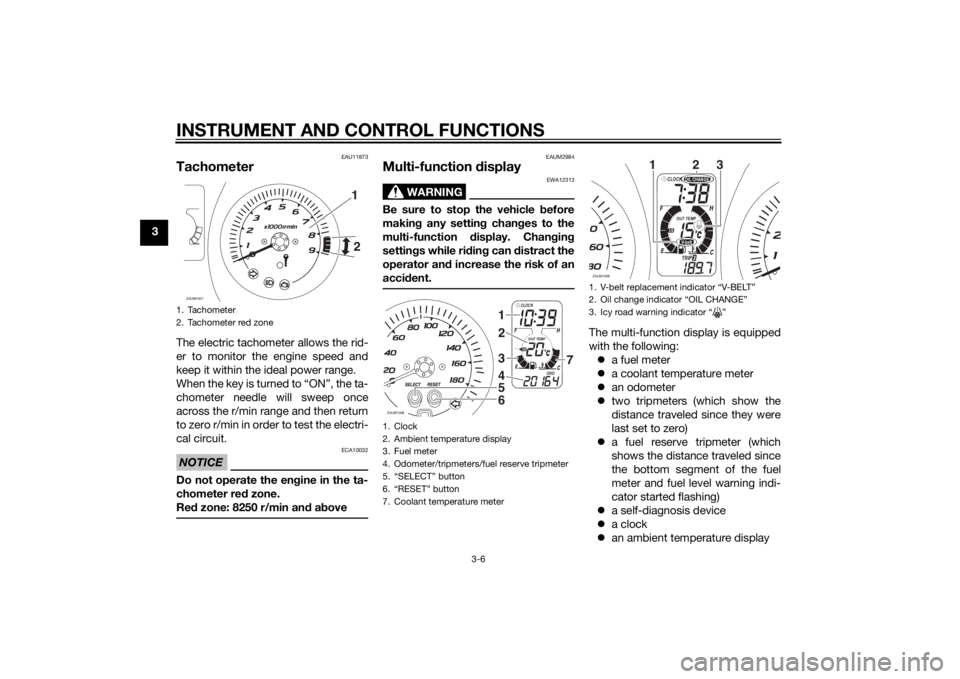
INSTRUMENT AND CONTROL FUNCTIONS
3-6
3
EAU11873
TachometerThe electric tachometer allows the rid-
er to monitor the engine speed and
keep it within the ideal power range.
When the key is turned to “ON”, the ta-
chometer needle will sweep once
across the r/min range and then return
to zero r/min in order to test the electri-
cal circuit.NOTICE
ECA10032
Do not operate the engine in the ta-
chometer red zone.
Red zone: 8250 r/min and above
EAUM2984
Multi-function display
WARNING
EWA12313
Be sure to stop the vehicle before
making any setting changes to the
multi-function display. Changing
settings while riding can distract the
operator and increase the risk of an
accident.
The multi-function display is equipped
with the following:
a fuel meter
a coolant temperature meter
an odometer
two tripmeters (which show the
distance traveled since they were
last set to zero)
a fuel reserve tripmeter (which
shows the distance traveled since
the bottom segment of the fuel
meter and fuel level warning indi-
cator started flashing)
a self-diagnosis device
a clock
an ambient temperature display
1. Tachometer
2. Tachometer red zoneZAUM1007
12
1. Clock
2. Ambient temperature display
3. Fuel meter
4. Odometer/tripmeters/fuel reserve tripmeter
5. “SELECT” button
6. “RESET” button
7. Coolant temperature meterZAUM1008
1/21/2CLOCKOUT TEMP
°CODO
65214
7
3
1.
2.
3. Icy road warning indicator ŽZAUM1009
1/21/2CLOCKOUT TEMP
°C
TRIP2
V- b e l tOIL CHANGE2
3
1
U1SDE1E0.book Page 6 Monday, September 23, 2013 3:55 PM
Page 23 of 92

INSTRUMENT AND CONTROL FUNCTIONS
3-7
3 an oil change indicator
a V-belt replacement indicator
TIPBe sure to turn the key to “ON” be-
fore using the “SELECT” and “RE-
SET” buttons.
When the key is turned to “ON”, all
of the display segments of the
multi-function display will appear
one after the other and then disap-
pear, in order to test the electrical
circuit.
For the UK, the distance traveled
is displayed in miles and the tem-
perature reading is displayed in
°C.
For other countries, the distance
traveled is displayed in kilometers
and the temperature reading is
displayed in °C.Odometer and tripmeter modes
Pushing the “SELECT” button switch-
es the display between the odometer
mode “Odo” and the tripmeter modes
“Trip” in the following order:
Odo → Trip 1 → Trip 2 → OdoWhen approximately 2.0 L (0.53 US
gal, 0.44 Imp.gal) of fuel remains in the
fuel tank, the bottom segment of the
fuel meter will start flashing, and the
display will automatically change to the
fuel reserve tripmeter mode “Trip F”
and start counting the distance trav-
eled from that point. In that case, push-
ing the “SELECT” button switches the
display between the various tripmeter
and odometer modes in the following
order:
Trip F → Trip 1 → Trip 2 → Odo → Trip
F
To reset a tripmeter, select it by push-
ing the “SELECT” button until “Trip” or
“Trip F” , push the “RESET” button for
at least one second. If you do not resetthe fuel reserve tripmeter manually, it
will reset itself automatically and the
display will return to the prior mode af-
ter refueling and traveling 5 km (3 mi).
TIPThe display cannot be changed back
button.Fuel meter
With the key in the “ON” position, the
fuel meter indicates the amount of fuel
in the fuel tank. The display segments
of the fuel meter disappear towards
“E” (Empty) as the fuel level decreases.
When the fuel level reaches the bottom
segment near “E”, the bottom segment
will flash. Refuel as soon as possible.
Coolant temperature meter
With the key in the “ON” position, the
coolant temperature meter indicates
the temperature of the coolant. The
coolant temperature varies with
changes in the weather and engine
load. If the top segment and coolant
temperature “C” “H” indicator flash,
stop the vehicle and let the engine
1. Fuel reserve tripmeterZAUM1010
1/21/2CLOCKOUT TEMP
°C
TRIP1
1
U1SDE1E0.book Page 7 Monday, September 23, 2013 3:55 PM
Page 24 of 92
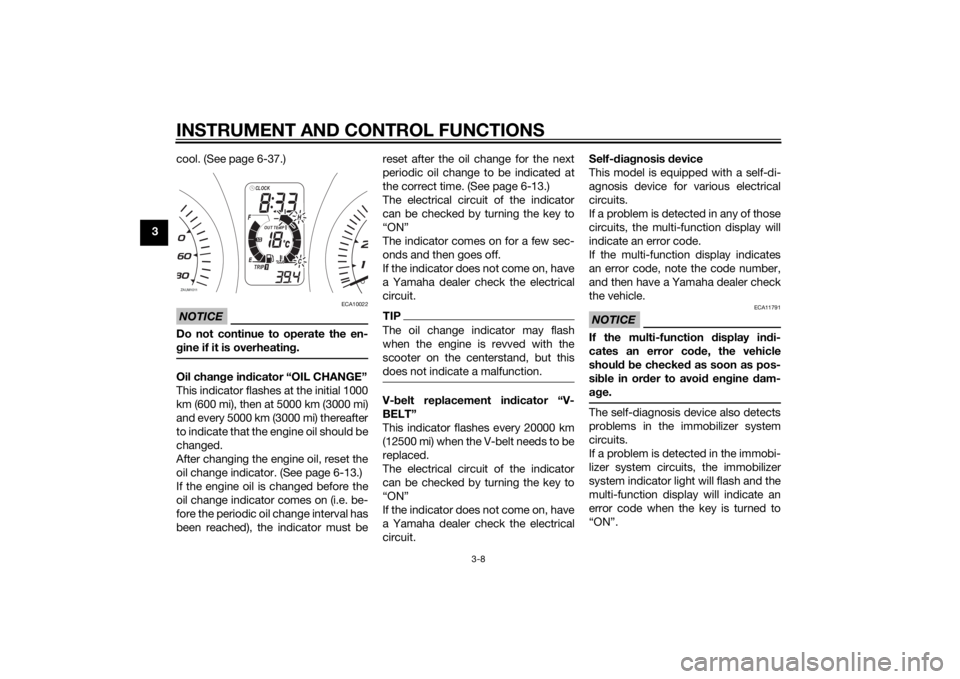
INSTRUMENT AND CONTROL FUNCTIONS
3-8
3cool. (See page 6-37.)
NOTICE
ECA10022
Do not continue to operate the en-
gine if it is overheating.Oil change indicator “OIL CHANGE”
This indicator flashes at the initial 1000
km (600 mi), then at 5000 km (3000 mi)
and every 5000 km (3000 mi) thereafter
to indicate that the engine oil should be
changed.
After changing the engine oil, reset the
oil change indicator. (See page 6-13.)
If the engine oil is changed before the
oil change indicator comes on (i.e. be-
fore the periodic oil change interval has
been reached), the indicator must bereset after the oil change for the next
periodic oil change to be indicated at
the correct time. (See page 6-13.)
The electrical circuit of the indicator
can be checked by turning the key to
“ON”
The indicator comes on for a few sec-
onds and then goes off.
If the indicator does not come on, have
a Yamaha dealer check the electrical
circuit.
TIPThe oil change indicator may flash
when the engine is revved with the
scooter on the centerstand, but this
does not indicate a malfunction.V-belt replacement indicator “V-
BELT”
This indicator flashes every 20000 km
(12500 mi) when the V-belt needs to be
replaced.
The electrical circuit of the indicator
can be checked by turning the key to
“ON”
If the indicator does not come on, have
a Yamaha dealer check the electrical
circuit.Self-diagnosis device
This model is equipped with a self-di-
agnosis device for various electrical
circuits.
If a problem is detected in any of those
circuits, the multi-function display will
indicate an error code.
If the multi-function display indicates
an error code, note the code number,
and then have a Yamaha dealer check
the vehicle.
NOTICE
ECA11791
If the multi-function display indi-
cates an error code, the vehicle
should be checked as soon as pos-
sible in order to avoid engine dam-
age.The self-diagnosis device also detects
problems in the immobilizer system
circuits.
If a problem is detected in the immobi-
lizer system circuits, the immobilizer
system indicator light will flash and the
multi-function display will indicate an
error code when the key is turned to
“ON”.
ZAUM1011
1/21/2CLOCKOUT TEMP
°C
TRIP1
U1SDE1E0.book Page 8 Monday, September 23, 2013 3:55 PM
Page 25 of 92
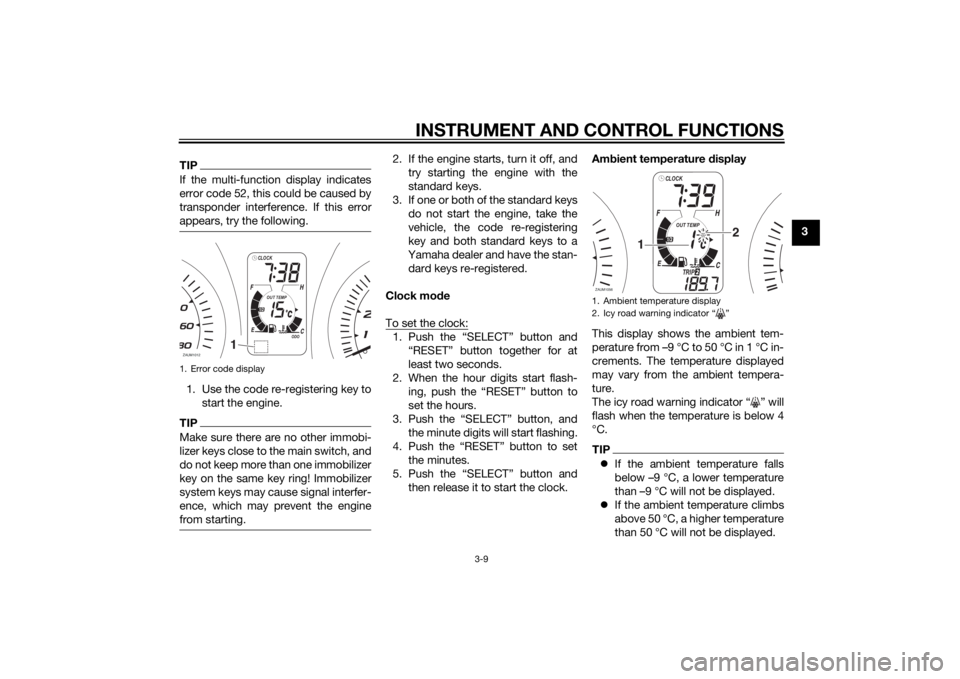
INSTRUMENT AND CONTROL FUNCTIONS
3-9
3
TIPIf the multi-function display indicates
error code 52, this could be caused by
transponder interference. If this error
appears, try the following.1. Use the code re-registering key to
start the engine.TIPMake sure there are no other immobi-
lizer keys close to the main switch, and
do not keep more than one immobilizer
key on the same key ring! Immobilizer
system keys may cause signal interfer-
ence, which may prevent the engine
from starting.
2. If the engine starts, turn it off, and
try starting the engine with the
standard keys.
3. If one or both of the standard keys
do not start the engine, take the
vehicle, the code re-registering
key and both standard keys to a
Yamaha dealer and have the stan-
dard keys re-registered.
Clock mode
To set the clock:1. Push the “SELECT” button and
“RESET” button together for at
least two seconds.
2. When the hour digits start flash-
ing, push the “RESET” button to
set the hours.
3. Push the “SELECT” button, and
the minute digits will start flashing.
4. Push the “RESET” button to set
the minutes.
5. Push the “SELECT” button and
then release it to start the clock.Ambient temperature display
This display shows the ambient tem-
perature from –9 °C to 50 °C in 1 °C in-
crements. The temperature displayed
may vary from the ambient tempera-
ture.
The icy road warning indicator “ ” will
flash when the temperature is below 4
°C.
TIPIf the ambient temperature falls
below –9 °C, a lower temperature
than –9 °C will not be displayed.
If the ambient temperature climbs
above 50 °C, a higher temperature
than 50 °C will not be displayed.
1. Error code displayZAUM1012
1/21/2CLOCKOUT TEMP
°CODO
1
1. Ambient temperature display
2. Icy road warning indicator ŽZAUM1056
1/21/2CLOCKOUT TEMP
°C
TRIP
2
2
1
U1SDE1E0.book Page 9 Monday, September 23, 2013 3:55 PM
Page 28 of 92

INSTRUMENT AND CONTROL FUNCTIONS
3-12
3
EAU12952
Rear brake leverThe rear brake lever is located on the
left side of the handlebar. To apply the
rear brake, pull this lever toward the
handlebar grip.
EAU54001
ABS (for ABS models)The Yamaha ABS (Anti-lock Brake
System) features a dual electronic con-
trol system, which acts on the front and
rear brakes independently.
Operate the brakes with ABS as you
would conventional brakes. If the ABS
is activated, a pulsating sensation may
be felt at the brake levers. In this situa-
tion, continue to apply the brakes and
let the ABS work; do not “pump” the
brakes as this will reduce braking ef-
fectiveness.
WARNING
EWA16051
Always keep a sufficient distance
from the vehicle ahead to match the
riding speed even with ABS.
The ABS performs best with
long braking distances.
On certain surfaces, such as
rough or gravel roads, the brak-
ing distance may be longer with
the ABS than without.The ABS is monitored by an ECU,
which will revert the system to conven-
tional braking if a malfunction occurs.
TIPThe ABS performs a self-diagno-
sis test each time the vehicle first
starts off after the key is turned to
“ON” and the vehicle has traveled
at a speed of 10 km/h (6 mi/h) or
higher. During this test, a “click-
ing” noise can be heard from the
front of the vehicle, and if either
brake lever is even slightly ap-
plied, a vibration can be felt at the
lever, but these do not indicate a
malfunction.
This ABS has a test mode which
allows the owner to experience
the pulsation at the brake levers
when the ABS is operating. How-
ever, special tools are required, so
please consult your Yamaha deal-
er when performing this test.NOTICE
ECA16121
Keep any type of magnets (including
magnetic pick-up tools, magnetic
screwdrivers, etc.) away from the
front and rear wheel hubs, otherwise
the magnetic rotors equipped in the
1. Rear brake leverU1SDE1E0.book Page 12 Monday, September 23, 2013 3:55 PM